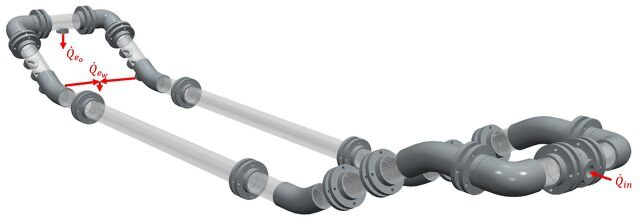Oil-water bulk separation for oil & gas applications (Short Project Description)
Description:
The benefits of subsea separation can be outlined as three separate aspects. Subsea separation of produced water can reduce the load on topside capacity and facilities, allowing for prolonged, increased production and avoiding bottlenecking. Subsea water separation also reduces the fluid pressure losses from the seabed to the topside, thus enabling more energy-efficient production. Finally, separation close to the well means less mixing and agitation, reducing dispersion formation and allowing for better separation.
A novel concept for subsea oil-water bulk separation has been developed, a prototype of the developed concept has been constructed, and the concept has been evaluated both experimentally and numerically by previous Ph.D. researcher Havard Skjefstad. For experimental testing, a down-scaled prototype of the separator concept has been constructed along with a low-pressure two-phase oil-water test facility. The prototype consists of two 150.6 mm internal diameter pipes in parallel, with a total horizontal length of 6.1 m. Four experimental campaigns have been executed, focusing on performance and operational envelope mapping, design feature evaluation, flow distribution, control strategy development and effect of upstream inlet choking and addition of surfactants. Experimental fluids are Exxsol D60 and distilled water with added NaCl. Separator performance is determined by flow rate, density, temperature and pressure measurements, and pictures of flow phenomena and established inlet droplet distributions are gathered for supplementary analysis.
The prototype exhibits good performance for a wide range of inlet flow rates and water cuts. Based on obtained results, design refinements are suggested and implemented, including preferred location for water extraction and an improved separator inlet configuration. An uneven flow splitting phenomenon is identified for certain flow conditions, which can be detrimental to operability and separator performance.
This project is carried out as a part of SUBPRO, a Research-based Innovation Center within Subsea Production and Processing. This work is financially supported from SUBPRO, which is financed by Research Council of Norway, major industry partners and NTNU.
Constructed and developed prototype showed high potential on multiphase flow separation. Therefore, the main goal is to make more efficient subsea bulk oil-water separation by improving separation design, understanding multiphase flow fundamentals and preventing undesired phenomena. For the next phase of this project following goals are aimed to investigate:
- Experimental study on the effect of small amounts of gas (air) on separation efficiency.
- Experimental study on the effect of effect of surfactants (e.g. crude oil spiking) on the separation efficiency and on the dispersion characteristics with or without inlet choking.
- Experimental and numerical study on the uneven flow splitting phenomenon between branches.
Following topics are considered as additional tentative goals:
- Numerical study of the fluid dynamics in the separator.
- Experimental study on the effect of oil viscosity on separation efficiency.
- Experimental and numerical studies to further refine separator design features.
- Experimental studies to determine optimal control strategies when there is slugging at the separator inlet.

Fig 1. Multi Parallel Pipe Separator (MPPS) prototype
No comments
Leave a reply
Cart
Cart is empty.